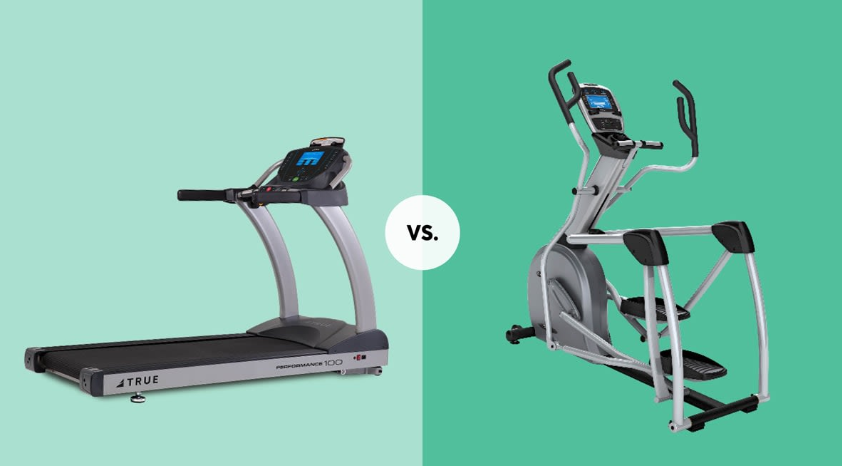Understanding the Treadmill and Elliptical
When embarking on a fitness journey, selecting the right cardio machine is crucial. Among the most popular choices are treadmills and ellipticals. Both of these machines are staples in gyms and home workout spaces due to their effectiveness in improving cardiovascular health. Understanding their unique features is essential in determining which one aligns best with your fitness objectives.
A treadmill is a versatile piece of equipment designed to simulate walking, jogging, or running. It typically features adjustable speed and incline settings, allowing users to customize their workouts. Treadmills are ideal for those aiming to enhance their endurance and engage in high-intensity interval training (HIIT). On the other hand, ellipticals offer a low-impact alternative. They mimic the motion of running without the harsh impact on joints, making them suitable for individuals with joint concerns or those seeking a gentler workout.
Both machines offer unique advantages, and understanding these can help users make informed decisions. The choice between a treadmill and an elliptical often depends on personal fitness goals, physical condition, and workout preferences. In this article, we will delve into the benefits, challenges, and specific features of each machine to guide you in selecting the best fit for your lifestyle.
Benefits of Using a Treadmill for Cardio
Treadmills are renowned for their ability to deliver a high-intensity cardiovascular workout. One of the primary benefits of using a treadmill is its capability to simulate outdoor running conditions. This feature makes it an excellent tool for those training for races or looking to improve their running performance. With adjustable speed and incline settings, users can replicate challenging terrain and enhance their endurance over time.
Another advantage of treadmills is their accessibility for all fitness levels. Beginners can start with a simple walking routine, gradually increasing the speed and incline as their fitness improves. More experienced users can engage in interval training, which alternates between high-speed sprints and slower recovery periods. This versatility makes treadmills suitable for a wide range of users, from novice exercisers to seasoned athletes.
Moreover, treadmills provide an effective calorie-burning workout. Running on a treadmill typically burns more calories than using an elliptical, making it a preferred choice for those aiming to lose weight. The ability to monitor heart rate, distance, and calorie expenditure further enhances the treadmill's appeal, allowing users to track their progress and stay motivated.
Benefits of Using an Elliptical for Cardio
Ellipticals are prized for their low-impact nature, offering an effective cardiovascular workout that is gentle on the joints. This makes them particularly appealing to individuals recovering from injuries or those with chronic joint issues, such as arthritis. By minimizing stress on the knees and hips, ellipticals allow users to engage in extended workouts without discomfort.
Another significant benefit of ellipticals is their ability to provide a full-body workout. Unlike treadmills, which primarily engage the lower body, ellipticals incorporate handles that facilitate upper body movement. This dual-action exercise targets multiple muscle groups, including the arms, shoulders, and core, in addition to the legs, promoting balanced muscle development.
Ellipticals also offer a variety of workout programs, from steady-state cardio to interval training. Users can adjust resistance and incline levels to challenge their cardiovascular system and build strength. This adaptability makes ellipticals suitable for individuals seeking to diversify their fitness routine and maintain long-term engagement with their workouts.
Comparing Calorie Burn: Treadmill Vs Elliptical
Calorie burn is a crucial factor for many individuals when choosing a cardio machine, particularly those focused on weight loss. Generally, running on a treadmill tends to burn more calories than using an elliptical. This is due to the higher intensity and engagement of larger muscle groups during a treadmill workout. However, it's essential to consider the specific workout intensity and duration when comparing calorie expenditure between the two machines.
When using a treadmill, factors such as speed, incline, and duration significantly influence calorie burn. High-intensity interval training (HIIT) on a treadmill can elevate heart rate and boost calorie burn, making it an effective strategy for those aiming to shed pounds. Conversely, a steady-state workout on an elliptical may burn fewer calories, but it allows for longer exercise sessions, which can be beneficial for endurance building.
It's important to note that individual factors such as weight, age, and fitness level also play a role in determining calorie expenditure. While treadmills may offer a slight edge in calorie burning, ellipticals provide a sustainable, low-impact alternative that can be equally effective with consistent use. Ultimately, the best choice depends on personal preferences, fitness goals, and how well the machine fits into one's routine.
Impact on Joints: Treadmill Vs Elliptical
The impact on joints is a critical consideration for those with existing joint issues or those looking to prevent future injuries. Treadmills, while effective for cardiovascular training, can pose a risk of joint strain, particularly when used for high-impact running. The repetitive pounding on hard surfaces can exacerbate conditions such as knee pain or shin splints, making it less suitable for individuals with joint concerns.
In contrast, ellipticals provide a low-impact workout that minimizes stress on the joints. The smooth, gliding motion of an elliptical mimics natural movements without the jarring impact associated with running. This makes ellipticals an advantageous option for rehabilitation, injury prevention, and long-term joint health. Additionally, the ability to adjust resistance and incline allows users to challenge their muscles without compromising joint integrity.
For those who enjoy running but are concerned about joint health, alternating between treadmill and elliptical workouts can offer a balanced approach. This strategy allows users to reap the benefits of both machines while reducing the risk of overuse injuries. Ultimately, listening to one's body and prioritizing joint health is essential in maintaining a sustainable and effective fitness routine.
Muscle Engagement: Treadmill Vs Elliptical
Understanding muscle engagement is key to maximizing the benefits of any workout. Treadmills primarily target the lower body, including the quadriceps, hamstrings, calves, and glutes. Running or walking on a treadmill engages these muscles intensively, promoting strength and endurance in the legs. Incline settings on treadmills can further enhance muscle activation by simulating uphill terrain.
In contrast, ellipticals offer a comprehensive full-body workout. The inclusion of handlebars allows for simultaneous upper body engagement, targeting the biceps, triceps, shoulders, and chest. This dual-action exercise is particularly beneficial for those seeking balanced muscle development and increased calorie expenditure. By adjusting resistance levels, users can simulate climbing, which intensifies muscle engagement and promotes cardiovascular fitness.
For individuals aiming for specific muscle goals, the choice between a treadmill and an elliptical can make a significant difference. Those focused on lower body strength and running performance may prefer the treadmill, while those seeking overall muscle toning and reduced impact on joints may find the elliptical more beneficial. Ultimately, incorporating both machines into a varied workout routine can offer comprehensive muscle engagement and prevent workout monotony.
Versatility and Workout Variety
Versatility and workout variety are crucial for maintaining motivation and preventing workout plateaus. Treadmills excel in offering diverse training options, from interval workouts to long-distance runs. Users can adjust speed, incline, and integrate various programs to tailor their sessions according to their fitness levels and goals. This adaptability keeps workouts engaging and challenging over time.
Ellipticals also provide ample workout variety with adjustable resistance and incline settings. Many ellipticals come equipped with pre-programmed workouts, such as hill climbs and interval training, allowing users to switch up their routines regularly. The ability to pedal in reverse on some ellipticals adds an extra dimension, engaging different muscle groups and enhancing workout diversity.
Incorporating both machines into a fitness regimen can offer the best of both worlds. By alternating between treadmill and elliptical workouts, users can target different muscle groups, prevent boredom, and continually challenge their bodies. This comprehensive approach ensures sustained interest and progress in one's fitness journey.
Cost and Maintenance Considerations
Cost and maintenance are important factors to weigh when choosing between a treadmill and an elliptical, especially for home gym setups. Treadmills can vary widely in price, with basic models available at affordable rates and high-end versions with advanced features costing significantly more. Maintenance for treadmills typically involves regular lubrication of the belt and occasional servicing to ensure optimal performance.
Ellipticals also come in a range of prices, with entry-level models being relatively cost-effective compared to premium options. Maintenance for ellipticals generally involves cleaning the machine, checking for loose parts, and ensuring the resistance system functions correctly. Overall, ellipticals tend to have lower maintenance needs due to their fewer moving parts compared to treadmills.
When considering cost and maintenance, it's essential to factor in the long-term investment in one's health and fitness. While upfront costs and upkeep are important, choosing a machine that aligns with personal preferences and fitness goals can lead to more consistent use and better results. Evaluating the available features, warranty options, and customer reviews can aid in making an informed decision.
User Experience and Personal Preferences
User experience and personal preferences play a pivotal role in selecting the right cardio machine. Some individuals relish the simplicity and directness of a treadmill workout, enjoying the ability to zone out during a run or walk. Others may prefer the smooth, rhythmic motion of an elliptical, which allows for multitasking, such as watching TV or reading, during a workout.
Comfort is another critical aspect influencing user experience. Treadmills require a certain level of balance and coordination, which can be challenging for some users, particularly beginners. Ellipticals, with their stable platforms and handles, offer a more supportive environment, making them accessible to individuals of all fitness levels.
Ultimately, the decision between a treadmill and an elliptical often boils down to personal enjoyment and motivation. Trying out both machines, if possible, can help determine which one feels more comfortable and engaging. Choosing a cardio machine that aligns with one's preferences increases the likelihood of regular use and long-term adherence to a fitness routine.
Choosing the Best Machine Based on Your Fitness Goals
Selecting the best cardio machine involves aligning it with your specific fitness goals. If weight loss is the primary objective, a treadmill may be more suitable due to its higher calorie-burning potential. The ability to perform HIIT on a treadmill can also accelerate fat loss and improve cardiovascular fitness. However, it's crucial to consider joint health and select low-impact options if necessary.
For those prioritizing joint health or seeking a full-body workout, ellipticals offer a balanced solution. The combination of upper and lower body engagement, along with adjustable resistance, allows users to target various muscle groups while minimizing joint stress. This makes ellipticals ideal for users focused on overall fitness and injury prevention.
Ultimately, the best choice depends on individual goals, preferences, and any physical limitations. Consulting with a fitness professional can provide valuable insights and help create a tailored workout plan that incorporates the most suitable cardio machine. By selecting the right equipment, individuals can enhance their fitness journey and achieve their desired outcomes.
Conclusion: Treadmill Vs Elliptical
In conclusion, both treadmills and ellipticals offer unique advantages and can be effective tools in achieving fitness goals. Treadmills excel in providing high-intensity, calorie-burning workouts, making them ideal for weight loss and endurance training. Conversely, ellipticals offer a low-impact, full-body workout that promotes joint health and balanced muscle development.


